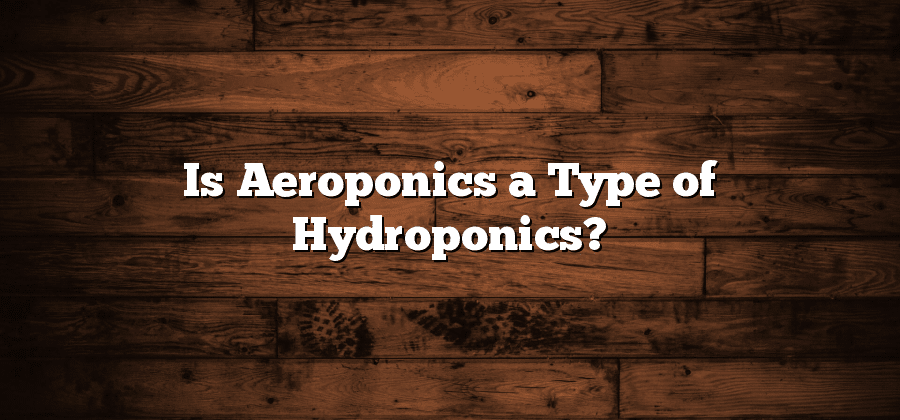What is Aeroponics and Hydroponics?
Aeroponics and hydroponics are two innovative cultivation methods that have gained popularity in recent years. Both techniques offer alternative ways of growing plants without the need for soil.
Aeroponics is a system that involves growing plants in an air or mist environment without any soil or growing medium. In this method, plant roots are suspended in the air, and a fine mist of nutrient-rich water is periodically sprayed onto them. This allows the roots to absorb the necessary nutrients directly from the mist, promoting faster and more efficient plant growth. Aeroponics is known for its ability to maximize oxygen levels around the roots and minimize water usage, making it a highly efficient and sustainable cultivation technique.
Hydroponics, on the other hand, is a method of growing plants in a nutrient-rich water solution, without the use of soil. Instead, plants are grown using an inert medium, such as clay pellets or coco coir, to provide physical support. The nutrient solution is delivered directly to the plant roots, either as a constant flow or through periodic flooding and draining. Hydroponics allows for precise control over nutrient levels, pH, and other growing conditions, resulting in faster growth and higher yields. This technique has gained popularity for its ability to optimize resource usage, reduce water waste, and produce crops all year round, regardless of the climate or soil quality.
Key Differences Between Aeroponics and Hydroponics
Aeroponics and hydroponics are two popular methods of soil-less cultivation that offer unique advantages and have distinct differences. One key difference between them lies in the way plants receive nutrients. In aeroponics, plants are suspended in air and receive a fine mist of nutrient solutions, allowing their roots to absorb nutrients directly. On the other hand, hydroponics involves submerging plant roots in a nutrient-rich water solution, which provides a constant supply of nutrients. This difference in nutrient delivery methods contributes to variations in plant growth rates and overall system setup.
Another notable difference between aeroponics and hydroponics is the level of moisture exposure to plant roots. In aeroponics, roots are exposed to the air, with intermittent misting, which helps in reducing water usage. In contrast, hydroponics immerse plant roots in water continuously, ensuring constant moisture supply. While both methods have their advantages, the differing moisture levels can impact the type of plants that can be grown in each system. It is important for growers to consider their specific crop requirements and environmental conditions when choosing between aeroponics and hydroponics.
Advantages of Aeroponics
One of the main advantages of aeroponics is its ability to save water. Compared to traditional farming methods, aeroponics requires much less water to grow plants. The plants are suspended in the air and only the necessary amount of water and nutrients are sprayed onto the roots. This efficient use of water not only conserves this precious resource but also reduces the cost of irrigation for farmers. Moreover, the misting system used in aeroponics ensures that water is evenly distributed to all plants, promoting balanced growth and better nutrient absorption.
Another advantage of aeroponics is its ability to maximize crop yields. By delivering nutrients directly to the roots, plants are able to absorb them more easily and efficiently. This results in faster and healthier growth, leading to higher yields. Additionally, the controlled environment in which aeroponics operates allows for year-round crop production, free from the limitations of seasonal changes and adverse weather conditions. Farmers can also stack multiple layers of plants, utilizing vertical space and increasing the overall productivity of their crops. This makes aeroponics an attractive option for maximizing food production in limited spaces.
Advantages of Hydroponics
Hydroponics is a highly efficient method of cultivating plants that offers numerous advantages. One major advantage of hydroponics is its ability to conserve water. Unlike traditional soil-based farming, hydroponics uses a controlled system where water is recirculated and reused. This significantly reduces water waste and helps to address the global issue of water scarcity.
Another advantage of hydroponics is its ability to produce higher yields in less space. With hydroponics, plants can be grown vertically using techniques such as vertical farming or the use of stacked layers. This vertical arrangement allows for more plants to be grown in a smaller footprint, increasing productivity. Additionally, the controlled environment of hydroponics eliminates the need for pesticides and herbicides, resulting in cleaner and healthier crops.
Disadvantages of Aeroponics
While aeroponics offers several benefits, it does come with some disadvantages that need to be considered. One major drawback is the complexity and cost of the system. Setting up an aeroponic system requires precise equipment and technology, which can be quite expensive for beginners or small-scale growers. Additionally, the maintenance and troubleshooting of the system can be challenging, requiring a deep understanding of the technology and its intricacies.
Another disadvantage of aeroponics is its susceptibility to power outages. Since the plants in aeroponic systems rely heavily on a continuous supply of water and nutrients, any interruption in the power supply can lead to disastrous consequences. Without power, the pumps and misting system will not function, depriving the plants of their essential needs and potentially causing irreparable damage. This risk makes it necessary for aeroponic growers to have backup power sources in place, adding to the overall cost and complexity of the system.






